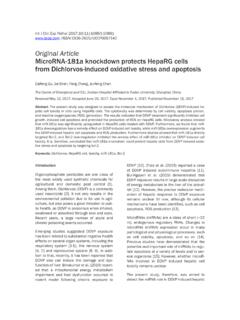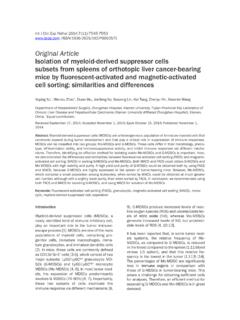Transcription of Original Article ROR1 promotes the proliferation of ...
1 Int J Clin Exp Pathol 2017;10(10) /ISSN:1936-2625/IJCEP0053278 Original Article ROR1 promotes the proliferation of endometrial cancer cellsHuilin Zhang1,2*, Xiaofang Yan1,4*, Jieqi Ke1, Yongli Zhang3, Chenyun Dai5, Mei Zhu5, Feizhou Jiang6, Xiaoping Wan1,31 Department of Obstetrics and Gynecology, Shanghai General Hospital of Nanjing Medical Unicersity, Shanghai, China; 2 Department of Obstetrics and Gynecology, Nanjing Maternity and Child Health Care Hospital, Obstetrics and Gynecology Hospital Affiliated to Nanjing Medical University, Nanjing, Jiangsu, China; 3 Department of Obstetrics and Gynecology, Shanghai First Maternity and Infant Hospital, School of Medicine, Tongji University, Shanghai, China; 4 Department of Gynecology and Obstetrics, Yixing People s Hospital, Yixing, Jiangsu Province, China; 5 Department of Translation Medicine, Shanghai First People s Hospital Affiliated to Shanghai Jiao Tong University, Shanghai, China; 6 Department of Obstetrics and Gynecology, The First Affiliated Hospital of Soochow University, Suzhou, China.
2 *Equal contributors. Received July 30, 2016; Accepted July 13, 2017; Epub October 1, 2017; Published October 15, 2017 Abstract: endometrial cancer (EC) is the most common gynecological malignant tumor. The canonical Wnt/ -catenin signaling pathway plays a key role in regulating carcinogenesis, and the noncanonical Wnt5a-ROR1 pathway is an important regulator of Wnt signaling. However, the molecular mechanism by which ROR1 influences Wnt signal-ing in EC is not known. In this study, we found that ROR1 is expressed at higher levels in tumor tissues and blood samples from patients with stage II EC compared with patients with stage I disease.
3 In vitro, human EC cell lines stably overexpressing ROR1 proliferated more rapidly and formed larger colonies than control cells . Consistent with this, overexpression or knockdown of ROR1 increased or decreased, respectively, the percentage of EC cells in M phase of the cell cycle. Elevated levels of ROR1 were associated with increased expression of Wnt5a and of cyclin D1 and c-Myc, two components of the Wnt signaling pathway. Finally, nude mice grew significantly larger tumors after subcutaneous injection of ROR1-overexpressing EC cells compared with control cells . These findings indicate a novel role for ROR1 in promoting EC cell proliferation by upregulating Wnt5a and stimulating the Wnt/ -catenin signaling : ROR1, Wnt5a, endometrial cancer , proliferation , Wnt signaling pathwayIntroductionEndometrial cancer (EC) is the most common gynecologic malignancy, with an incidence of 47,130 new cases and 8010 deaths in 2014 [1].
4 Type 1 EC, also known as endometrioid EC, accounts for 70%-80% of all EC cases [2]. Although proliferation is a common feature of the disease and hampers cancer therapy, the underlying molecular mechanisms controlling EC cell proliferation are not receptor-tyrosine-kinase-like orphan recep-tor 1 (ROR1), a transmembrane protein and member of the receptor tyrosine kinase family, is involved in skeletal and neural development [3], but is rarely expressed in adult tissues [4]. However, ROR1 is overexpressed in malignant tumors [5] where it is associated with aggres-sive disease and poor prognosis [6].
5 The Wnt signaling pathway is known to be involved in endometrial carcinogenesis [7]. Wnt5a is the key ligand activating the Wnt sig-naling pathway, and promotes cancer cell prolif-eration and cell migration during organogene-sis. Wnt5a is overexpressed in ovarian cancer cells in vivo and high levels are associated with increased cell proliferation in vitro [8]. Binding of Wnt5a to its receptor ROR1 [9] medi-ates enhanced tumor cell growth [10] through both the canonical and noncanonical Wnt sig-naling pathways [11]. Hence, we considered that ROR1 might have clinicopathological sig-nificance in promotes endometrial cancer10604 Int J Clin Exp Pathol 2017.
6 10(10):10603-10610In this study, we analyzed the relationship between ROR1 and EC by examining the ex- pression of ROR1 in blood samples and paraf-fin-embedded tumor tissues from EC patients, the effect of ROR1 overexpression or knock-down on EC cell proliferation in vitro, and the correlation between expression of ROR1 and that of Wnt5a and proteins in the Wnt signaling and methodsPatient samples and EC cell linesThe protocols used in this study were approved by the Hospital s Protection of Human Subjects Committee. Samples were obtained from the Shanghai First People s Hospital Affiliated to Shanghai Jiaotong University.
7 All patients pro-vided written informed were taken from 52 patients with EC, of whom 25 had stage I and 27 had stage II disease, between Januay 2014 and December 2015. The histological grade (G2-G3) and stage were established according to the criteria of the International Federation of Gynecology and Obstetrics surgical staging system (2009) [12]. Blood samples were taken from 26 patients wi- th EC (12 satge I, 14 stage II) for PCR analysis. The human EC cell lines Ishikawa and HEC-1B were obtained from and maintained as recom-mended by the American Type Culture Collection (Manassas, VA).
8 ImmunohistochemistryImmunohistochemistry (IHC) was performed on sections of paraffin-embedded patient tumor samples according to the manufacturer s rec-ommendations. Staining was scored indepen-dently by two pathologists who were blinded to the clinical and pathological data. Protein stain-ing was evaluated as described [13]. RNA extraction and analysisRNA extraction from blood samples and reverse transcription were performed according to the manufacturer s protocols. Human ROR1 was amplified by real-time PCR and ROR1 mRNAs levels were normalized to -actin using dCt val-ues. The primer pairs used were: human ROR1 forward: 5 -TAATCGGAGAGCAACTTCA-3 , rever- se: 5 -TGTAGTAATCAGCGGAGTAA-3.
9 -actin for-ward: 5 -TTAATCTTCGCCTTAATACTT-3 , reverse: 5 -AGCCTTCATACATCTCAA-3 .Western blot analysisWestern blotting was performed as previously described [14]. The primary antibodies were rabbit anti-ROR1 (Abcam, Cambridge, UK; 135- 669), rabbit anti-GAPDH (Abcam, ab9485), rabbit anti-Wnt5a (Abcam, ab72538), rabbit anti-cyclin D1 (Abcam, ab16663), rabbit anti-c- Myc (Abcam, ab32072), and rabbit anti-Ki67 (Abcam, 16667).Establishment of transfected EC cells linesHEC-1B cell lines transfected with an ROR1 overexpression plasmid or an ROR1 shRNA-encoding plasmid were established as previ-ously described [15].
10 Cell viability assayViable cells was enumerated using the 3-(4,5- dimethylthiazol-2yl)-2,5-diphenyltetrazo lium bromide (MTT) assay as described [16]. Cell cycle analysis by flow cytometryCells were transfected with ROR1 plasmids for 48 h and then steps were performed according to the manufacturer s protocol. After FACS analysis, the cell profiles were analyzed using ModFit ROR1 cDNA plasmid was purchased from Origene (Rockville, MD, USA; RC214967). The ROR1 RNAi (shRNA) plasmid was constructed by cloning the target sequence (5 -TTACTAGGA- GACGCCAATA-3 ) into the pCMV6-Entry 1.
















